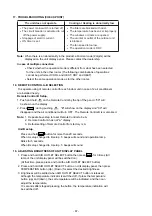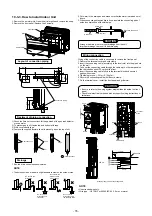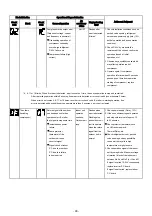
.
AIR PURGE
Evacuate the air in the connecting pipes and in the
indoor unit using a vacuum pump. Do not use the
refrigerant in the outdoor unit. For details, see the
manual of the vacuum pump.
<Using a vacuum pump>
Be sure to use a vacuum pump with counter-flow
prevention function so that inside oil of the pump does
not flow backward into pipes of the air conditioner
when the pump stops. (If oil inside of the vacuum
pump enters into the air conditioner, which use R32
or
R410A,
refrigeration cycle trouble may result.)
1. Connect the charge hose from the manif
e to
old valv
the service port of the gas side packed valve.
2. Connect the charge hose to the port of the vacuum
pump.
3. Open fully the low pressure side handle of the
gauge manifold valve.
4. Operate the vacuum pump to start evacuating.
Perform evacuating for about 15 minutes if the
piping length is 20 meters. (15 minutes for
20 meters) (assuming a pump capacity of 27 liters
per minute. Then confirm that the compound
pressure gauge reading is -101 kP a (76 cmHg).
5.
6.
Close the low pressure side valve handle of gauge
manifold.
Open fully the valve stem of the packed valves
(both side of Gas and Liquid).
7. Remove the charging hose from the service port.
8. Securely tighten the caps on the packed valves.
Compound pressure gauge
Packed valve at gas side
Service port (Valve core (Setting pin))
Packed valve at liquid side
Pressure gauge
Manifold valve
Handle Hi
(Keep full closed)
Charge hose
Charge hose
Handle Lo
Connecting pipe
Vacuum pump adapter for
counter-flow prevention
Vacuum
pump
–101 kPa (–76 cmHg)
<Packed valve handling precautions>
•
Open the valve stem all the way out, but do not try
to open it beyond the stopper.
•
Securely tighten the valve cap with torque in the
following table
CAUTION
•
1)
KEEP IMPORTANT
6
POINTS FOR PIPING WORK
Take away dust and moisture (inside of the
connecting pipes).
2) Tighten the connections (between pipes and
unit).
3) Evacuate the air in the connecting pipes using a
VACUUM PUMP.
4) Check gas leak (connected points).
5) Be sure to fully open the packed valves before
operation.
6) Reusable mechanical connectors and flared
joints are not allowed indoors. When
mechanical connectors are reused indoors,
sealing parts shall be renewed. When flared
joints are reused indoors, the fl are part shall be
refabricated.
Hexagon wrench
is required.
4 mm
Gas side
(Ø12.70 mm)
50 to 62 N
•
m
(5.0 to 6.2 kgf
•
m)
Gas side
(Ø9.52 mm)
33 to 42 N
•
m
(3.3 to 4.2 kgf
•
m)
Liquid side
(Ø6.3
5
mm)
14 to 18 N
•
m
(1.4 to 1.8 kgf
•
m)
Service port
14 to 18 N
•
m
(1.4 to 1.8 kgf
•
m)
Wiring Connection
1.
Remove the valve cover, the electric parts cover
and the cord clamp from
the outdoor unit.
2.
Connect the connecting cable to the terminal as
identified by the matching
numbers on the terminal
block of indoor and outdoor unit.
3. Insert the power cord and the connecting cable
fully into the terminal block and secure it tightly with
screws.
4. Use vinyl tape, etc. to insulate the cords which are
not going to be used. Locate them so that they do
not touch any electrical or metal parts.
5. Secure the power cord and the connecting cable
with the cord clamp.
6. Attach the electric parts cover and the valve cover
on the outdoor unit.
- 80 -
















































